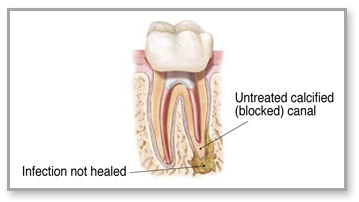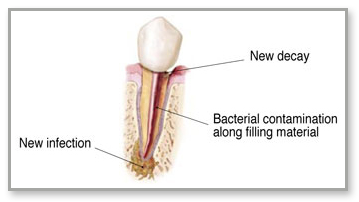Services
Root canal therapy
Our primary goal is to save your natural teeth whenever possible. Our practice specializes in Endodontics, commonly referred to as root canal therapy. Root canal therapy is a very common dental procedure. According to recent statistics in the United States alone close to 15 million are done over the course of a year. Because it has average 90% success rate, a root canal procedure is considered one of the most effective methods of saving and retaining a tooth that has been severely compromised by dental decay or injury.
How is a root canal performed?
With the modern dental instruments and advanced techniques available today having a non-surgical root canal procedure is often as comfortable as getting a routine dental filling. While some root canals can be completed in one visit, others may involve 2 or 3 appointments. How long it takes depends on factors such as the number of canals in a tooth, possible calcification of the canals, their anatomy and whether an active infection is present. If it is determined that the tooth is not a candidate for a root canal procedure, or if complications develop during or after care that have an impact on the prognosis of your tooth, your endodontist will inform you.
During a non-surgical root canal procedure your endodontist will numb your tooth, remove the diseased dental pulp, clean the internal portion of your tooth, and then fill all the prepared canals with a biocompatible filling material. Non-surgical root canal therapy is typically performed under local anesthesia, but additional options like nitrous oxide, IV and oral sedation may be available to reduce any anxiety that may be associated with dental procedures. The video below explains root canal treatment.
Endodontic Re-treatment
As occasionally happens with any dental or medical procedure, a tooth may not heal as expected after initial treatment for a variety of reasons:
• Narrow or curved canals were not treated during the initial procedure.
• Complicated canal anatomy went undetected in the first procedure
• The placement of the crown or other restoration was delayed following the endodontic treatment
• The restoration did not prevent salivary contamination to the inside of the tooth
In other cases, a new problem can jeopardize a tooth that was successfully treated previously.
For example:
• New decay can expose the root canal filling material to bacteria, causing a new infection in the tooth
• A loose, cracked or broken crown or filling can expose the tooth to new infection
• A tooth sustains a fracture


Cracked Teeth
There are many different types of cracked teeth. The treatment and outcome for your tooth depends on the type, location, and extent of the crack.

Craze Lines
Craze lines are tiny cracks that affect only the outer enamel. These cracks are extremely common in adult teeth. Craze lines are very shallow, cause no pain, and are of no concern beyond appearances.

Fractured Cusp
When a cusp (the pointed part of the chewing surface) becomes weakened, a fracture sometimes results. The weakened cusp may break off by itself or may have to be removed by the dentist. When this happens, the pain will usually be relieved. A fractured cusp rarely damages the pulp, so root canal treatment is seldom needed. Your tooth will usually be restored with a full crown by your dentist.

Vertical Root Fracture
Vertical root fractures are cracks that begin in the root of the tooth and extend toward the chewing surface. They often show minimal signs and symptoms and may go unnoticed for some time. They are often discovered when the surrounding bone and gum become infected. Treatment may involve extraction. Endodontic surgery is sometimes appropriate if a portion of the tooth can be saved by removal of the fractured root.

Split Tooth
A split tooth is often the result of the long term progression of a cracked tooth. The split tooth is identified by a crack with distinct segments that can be separated. A split tooth cannot be saved intact. The position and extent of the crack, however, will determine whether any portion of the tooth can be saved. In rare instances, endodontic treatment and a crown or other restoration by your dentist may be used to save a portion of the tooth.

Cracked Tooth
This crack extends from the chewing surface of the tooth vertically towards the root. A cracked tooth is not completely separated into two distinct segments. Because of the position of the crack, damage to the pulp is common. Root canal treatment is frequently needed to treat the injured pulp. Your dentist will then restore your tooth with a crown to hold the pieces together and protect the cracked tooth. At times, the crack may extend below the gingival tissue line, requiring tooth extraction. A nontreatable tooth is shown in the graphic above. Early diagnosis is important. Even with high magnification and special lighting, it is sometimes difficult to determine the extent of a crack. A cracked tooth that is not treated will progressively worsen, eventually resulting in the loss of the tooth.
Early diagnosis and treatment are essential in saving these teeth.
Apicoectomy
(Apical Microsurgery)
Generally, root canal treatment or retreatment is all that is needed to save teeth with injured pulp from extraction. Occasionally, these non-surgical procedures will not be sufficient to heal the tooth and your endodontist may recommend apical surgery (apicoectomy). An apicoectomy is an excellent next step procedure to preserve a previously treated tooth, eliminate a dental infection, and to restore the health of the surrounding tissues. It is most useful in cases where fractures or hidden canals still cause pain or infection around a treated tooth, as well as when an endodontic retreatment procedure is not recommended as it could further weaken and jeopardize the retainability of the tooth.
An apicoectomy is typically performed under local anesthesia. It is usually a straightforward procedure during which an incision is made in the gum tissue at the involved tooth and adjacent teeth. This is to expose the inflamed or infected tissue surrounding the root tip of the tooth. Once uncovered, the damaged tissue in the area is removed along with a few millimeters of the tooth’s root tip. A biocompatible filling material is then placed in the end of the remaining portion of the root to re-seal it and prevent any possibility of reinfection. The gum tissue flap is put back into place and sutured to complete the procedure.
Post-surgical discomfort is generally mild and you may have some swelling or bruising in the area. Most patients return to their normal activities very quickly. Application of a cold compress can reduce discomfort and swelling after the procedure. The appropriate pain medication will be prescribed or recommended. If your discomfort does not respond to medication, or other symptoms that concern you develop, please call our office.
Prior to undergoing an apicoectomy the endodontist will discuss all the risks and benefits of the procedure. If during the course of the surgery any significant fractures are discovered in the tooth that changes the prognosis, you will be immediately advised.
Traumatic Injuries
Traumatic injuries can result in the need for dental treatment. Fractured or cracked teeth, a displaced tooth, or even a tooth that has been knocked out (avulsed) are common results of dental trauma. Each of these conditions requires specific treatment, dictated by the effect of the injury on the tooth, whether or not the tooth is primary (a baby tooth) or permanent (adult), and the time between the injury and treatment, among other considerations. Treatment may include a splint, medication, a root canal or other procedures. Once treated, your tooth will be monitored to ensure it is healing as expected and so that any injuries or infections can be quickly resolved.
Dislodged Teeth
As the result of a dental injury a tooth can be partially pushed into or pulled out of its socket.
In situations where a tooth is partially pushed out of its socket, your general dentist or endodontist may reposition and stabilize the tooth. If the pulp of the tooth remains healthy, no other treatment is necessary. However, if the pulp becomes damaged or infected, a root canal therapy is necessary.
Injuries to the mouth can cause teeth to be pushed back into their sockets. Your endodontist or general dentist may reposition and stabilize your tooth. Root canal treatment is usually started within a few weeks of the injury and a medication, such as calcium hydroxide, will be placed inside the tooth. Eventually, a permanent root canal filling will be placed.
Avulsed Teeth
When a tooth has been completely knocked out of the mouth, it is important to get to the endodontist or general dentist as quickly as possible. It is important to handle the tooth carefully to avoid further damage. The main thing is to keep the tooth moist. You can place the tooth in milk or a glass of water (add a pinch of salt). Keep in mind that only permanent teeth should be re-implanted.
Since the nerve and blood supply of the tooth is damaged when the tooth is avulsed, a root canal may be needed based upon the stage of root development. Your endodontist will determine this. The length of time the tooth was out of your mouth and the way the tooth was stored, may influence the type of treatment you receive as well as the ultimate prognosis for the tooth.
Injuries in Children
A permanent tooth in a child might not be fully developed at the time of injury. There are special considerations in terms of root development that are taken into account in these cases. An immature tooth may require one of the following procedures to improve the chances of retaining the tooth:
Apexogenesis
The intent of apexogenesis in injured immature teeth is to preserve vital pulp tissue so that continued root development with root tip maturation (root tip closure) may occur. During this procedure a special medication to encourage normal development and maturation of the root is placed inside of the tooth. The injured tooth is then closely followed to determine if successful root formation is taking place. In cases where the pulp heals, no additional treatment will be necessary. The more mature the root becomes, the better the chance of saving the tooth.
Apexification
If the vital tissue inside an immature tooth is irreversibly damaged a procedure known as apexification may be performed. The intent of this procedure is to induce the formation of a hard tissue barrier near the root tip. This hardened tissue provides a stop for the root canal filling material. At this point, the root canal walls will not continue to develop, making the tooth susceptible to fractures. Since the structural integrity of the tooth may be compromised, it is important that the tooth have a proper final restoration placed as soon as possible after endodontic treatment.
